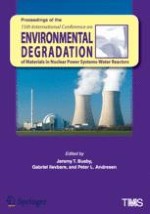2016 | Buch
Proceedings of the 15th International Conference on Environmental Degradation of Materials in Nuclear Power Systems — Water Reactors
herausgegeben von: Jeremy T. Busby, Gabriel Ilevbare, Peter L. Andresen
Verlag: Springer International Publishing
